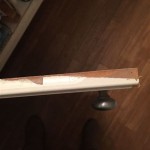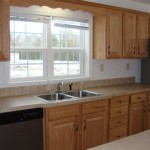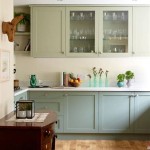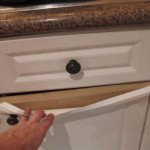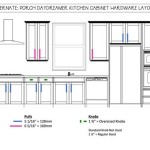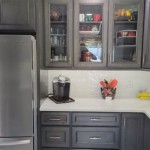Installing Slide-Out Shelves in Kitchen Cabinets
Kitchen cabinets, while providing necessary storage, often suffer from inefficient space utilization. Items stored at the back of deep cabinets can be difficult to access, leading to forgotten groceries and wasted space. One effective solution to this common problem is the installation of slide-out shelves. These shelves, also known as pull-out shelves or roll-out trays, significantly improve accessibility and organization within kitchen cabinets. This article provides a comprehensive guide on how to install slide-out shelves in kitchen cabinets, detailing the necessary tools, materials, and step-by-step instructions to achieve a successful outcome.
The decision to install slide-out shelves is a worthwhile investment for any homeowner seeking to enhance the functionality and usability of their kitchen space. By bringing items to the user, rather than requiring them to reach deep inside, slide-out shelves reduce the risk of strain and make everyday cooking tasks more convenient. Furthermore, the enhanced visibility within the cabinet minimizes food waste and promotes a more organized kitchen environment.
Key Point 1: Preparation and Planning
Before commencing the installation process, thorough preparation and careful planning are essential. This includes accurate measurement of the cabinet interiors, selection of appropriate slide-out shelves, and gathering all necessary tools and materials. Failure to adequately prepare can result in improperly fitting shelves and potential installation challenges.
The initial step is to accurately measure the interior dimensions of the kitchen cabinets where the slide-out shelves will be installed. Specifically, measure the width, depth, and height of the cabinet opening. It is crucial to account for any obstructions, such as pipes or existing shelf supports. The width measurement is particularly important, as it will determine the required distance between the slide rails. The depth measurement will dictate the maximum depth of the slide-out shelf. The height measurement will help decide spacing between shelves if multiple shelves are being installed in one cabinet.
Once the cabinet dimensions are recorded, the next step is to choose the appropriate slide-out shelves. These shelves are available in a variety of materials, including wood, metal, and plastic. Wooden shelves offer a classic aesthetic and can be stained or painted to match existing cabinetry. Metal shelves are known for their durability and are often coated to prevent rust and corrosion. Plastic shelves are a more economical option but may not be as sturdy as wood or metal. Consider the weight capacity of the shelves and the types of items that will be stored on them. The shelves can be purchased pre-assembled or as a DIY kit requiring assembly.
The type of drawer slides is another critical factor. Common options include ball-bearing slides, which offer smooth and quiet operation, and epoxy-coated slides, which are more affordable but may not be as durable. Select slides that are rated for the weight of the shelf and its contents. Full-extension slides allow the shelf to be pulled out completely, maximizing access, while three-quarter extension slides are a more economical option.
After selecting the shelves and slides, gather the necessary tools and materials. This includes a measuring tape, pencil, drill with various drill bits, screwdriver (both Phillips head and flathead), level, safety glasses, and wood screws. It is also advisable to have a stud finder on hand to locate any studs in the cabinet walls, especially if the cabinets are not constructed of solid wood.
Key Point 2: Installation Process
The installation of slide-out shelves involves attaching the drawer slides to the cabinet walls and then securing the shelves to the slides. Precision and attention to detail are paramount to ensure smooth operation and prevent misalignment. It is recommended to work systematically, following each step carefully to avoid errors.
Start by marking the desired location of the drawer slides inside the cabinet. Use the measuring tape and level to ensure that the marks are aligned and equidistant from the top and bottom of the cabinet opening. The height of the shelves will depend on the items planned to be stored on them. Allow sufficient vertical clearance for taller items. If installing multiple shelves, ensure that the spacing between each shelf is consistent.
Next, attach the drawer slides to the cabinet walls using wood screws. Pre-drilling pilot holes can prevent the wood from splitting, especially when working with hardwoods. Ensure that the slides are flush with the marked lines and that the screws are securely fastened. Use a level to verify that the slides are perfectly horizontal. Any slight deviation can result in a shelf that does not slide smoothly. The drawer slides need to be attached in parallel so that the slide-out shelf doesn't bind when it is pulled out or pushed in.
If the cabinet walls are not solid wood, it may be necessary to use wall anchors or toggle bolts to provide additional support for the screws. These fasteners are designed to grip the drywall or other material behind the cabinet wall, preventing the screws from pulling out under heavy loads. A stud finder can be used to locate wall studs. If a stud is located at a desired mounting location, use longer screws to secure the slide bracket directly to the stud.
Once the drawer slides are securely attached to the cabinet walls, slide the corresponding portions of the slides onto the shelves. Align the slides with the edges of the shelves and secure them with wood screws. Again, pre-drilling pilot holes is recommended to prevent splitting. Ensure that the slides are flush with the edges of the shelves and that the screws are tightened securely.
Finally, carefully slide the shelves into the cabinet, engaging the slides on the shelves with the slides mounted on the cabinet walls. Push the shelves in and out several times to test the smoothness of the operation. If the shelves bind or catch, inspect the alignment of the slides and adjust as needed. It may be necessary to loosen the screws and reposition the slides slightly to achieve optimal performance.
Key Point 3: Troubleshooting and Refinement
Even with careful planning and execution, minor issues may arise during the installation process. Troubleshooting these issues and refining the installation can ensure long-term functionality and satisfaction. Common problems include misalignment, binding, and instability. Addressing these issues promptly can prevent further complications.
If the shelves do not slide smoothly, the first step is to inspect the alignment of the drawer slides. Use a level to verify that the slides are horizontal and parallel. If the slides are misaligned, loosen the screws and reposition them as needed. It may also be necessary to add shims behind the slides to correct for uneven surfaces or variations in cabinet construction.
Binding can also be caused by obstructions inside the cabinet. Check for any pipes, wires, or other objects that may be interfering with the movement of the shelves. If necessary, relocate these obstructions or modify the shelves to accommodate them. It may also be necessary to trim the edges of the shelves if they are too wide for the cabinet opening.
If the shelves feel unstable or wobbly, ensure that the drawer slides are securely attached to both the cabinet walls and the shelves. Tighten the screws and consider using longer screws or wall anchors for added support. It may also be necessary to reinforce the shelves with additional supports, such as brackets or cleats, especially if they will be holding heavy items.
Once the installation is complete and the shelves are functioning smoothly, consider adding finishing touches to enhance their appearance and functionality. This may include installing edge banding to cover the exposed edges of the shelves, applying a sealant or varnish to protect the wood from moisture, or adding dividers or organizers to keep items neatly arranged.
Regular maintenance is essential to ensure the long-term performance of the slide-out shelves. Periodically clean the slides with a dry cloth to remove dust and debris. Lubricate the slides with a silicone-based lubricant to maintain smooth operation. Inspect the screws regularly and tighten them as needed. By following these simple maintenance tips, the slide-out shelves will provide years of reliable service, enhancing the functionality and organization of the kitchen cabinets.
Installing slide-out shelves in kitchen cabinets is a practical and effective way to improve accessibility, organization, and overall kitchen functionality. By following the steps outlined in this guide, homeowners can successfully install these shelves and enjoy the benefits of a more efficient and user-friendly kitchen space. Taking the time to measure accurately, select appropriate materials, and execute the installation with precision will ensure a satisfactory and long-lasting result.

How To Make Simple Easy Sliding Shelves

How To Make Simple Easy Sliding Shelves

Installing Sliding Shelves In A Pantry Southern Hospitality

Installing Sliding Shelves In A Pantry Southern Hospitality

Installing Sliding Shelves In A Pantry Southern Hospitality

Installing Gliding Shelves In A Frameless Cabinet

Kitchen Organization Pull Out Shelves In Pantry Remodelando La Casa

Build Pull Out Shelves For Kitchen Cabinets
Made To Fit Slide Out Shelves For Existing Cabinets By A Shelf Costco

Kitchen Storage Pull Out Pantry Shelves Diy Family Handyman
Related Posts



